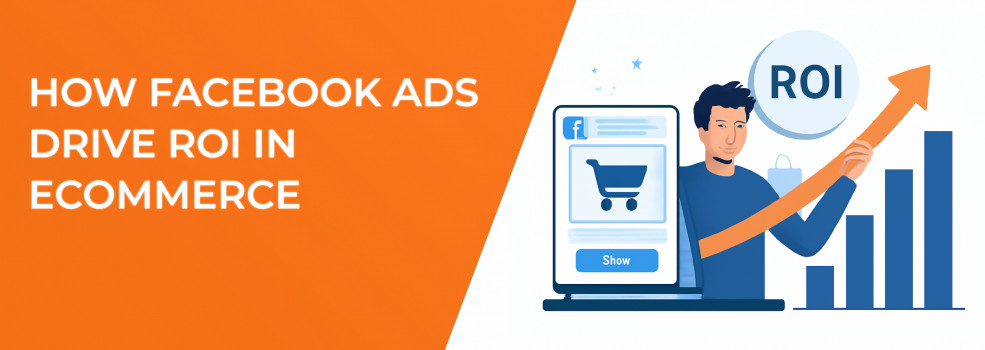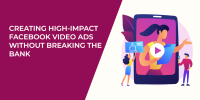Businesses of all sizes are leveraging Facebook Ads to maximize return on investment (ROI) in ecommerce. Whether you're a small startup or an established brand, Facebook offers powerful tools to reach a vast audience, drive sales, and boost customer engagement. But how exactly do Facebook Ads contribute to ecommerce ROI? Let’s break it down.
Understanding Facebook Ads and Ecommerce ROI
Facebook Ads allow businesses to reach millions of users worldwide, creating a massive opportunity for ecommerce brands. These ads can be finely tuned to target specific audiences, including by location, interests, and demographics. But beyond just reaching an audience, Facebook Ads can directly drive sales, leading to a measurable return on investment.
At the core of Facebook Ads' effectiveness is the ability to optimize campaigns. This means not just running an ad, but continuously adjusting and refining it based on user interactions, campaign performance, and strategic goals. This kind of optimization is essential for driving better results and higher ROI.
For ecommerce businesses, timing can be everything. Learn how to maximize your Facebook Ads during peak seasons for better results in our dedicated article.
Custom Audiences: A Key to Targeting the Right People
One of the most powerful features of Facebook Ads is the ability to create custom audiences. These are groups of users specifically tailored to match the ideal customer profile for your ecommerce business. By utilizing custom audience features, you can ensure that your ads are being shown to the most relevant people — those who are most likely to convert into paying customers.
How to create a custom audience:
-
Use customer lists: Upload data from previous customers, like emails or phone numbers.
-
Target website visitors: Use Facebook Pixel to retarget people who visited your site.
-
Leverage engagement data: Target people who have interacted with your posts, videos, or previous ads.
-
Build lookalike audiences: Find new customers similar to your best existing ones.
Creating a custom audience on Facebook is simple and can be based on a variety of factors, increasing the chances of higher conversion rates.
To get the most out of your Facebook Ads, it's essential to understand your target audience. Learn how to define a target audience effectively in our step-by-step guide.
Facebook Ad Optimization: Maximizing Campaign Performance
To achieve the highest possible ROI, it’s crucial to continuously optimize your Facebook ads. Optimization involves making data-driven decisions to improve ad performance. This can include adjusting your campaign budget, experimenting with different ad formats (like carousel ads or video ads), and utilizing Facebook’s AI tools to refine targeting.
Best practices for Facebook Ad optimization:
-
Track performance with Facebook Pixel: Use the data to understand user actions on your website.
-
Experiment with ad formats: Try carousel ads, slideshows, and video ads to see which resonate best with your audience.
-
Test different creatives: Run A/B tests to understand which visuals, headlines, and CTAs perform better.
-
Refine targeting: Continuously adjust who sees your ads based on real-time results.
Additionally, tools like Facebook Pixel can be used to track the effectiveness of your ads. Facebook Pixel allows you to measure the actions users take on your website after interacting with an ad, providing valuable insights into conversion rates and customer behavior. This data can then be used to fine-tune your ad strategy, ensuring your budget is being used efficiently.
Businesses of all sizes are leveraging Facebook Ads to maximize return on investment (ROI) in ecommerce. Whether you're a small startup or an established brand, Facebook offers powerful tools to reach a vast audience, drive sales, and boost customer engagement. But how exactly do Facebook Ads contribute to ecommerce ROI? Let’s break it down.
Understanding Facebook Ads and Ecommerce ROI
Facebook Ads allow businesses to reach millions of users worldwide, creating a massive opportunity for ecommerce brands. These ads can be finely tuned to target specific audiences, including by location, interests, and demographics. But beyond just reaching an audience, Facebook Ads can directly drive sales, leading to a measurable return on investment.
At the core of Facebook Ads' effectiveness is the ability to optimize campaigns. This means not just running an ad, but continuously adjusting and refining it based on user interactions, campaign performance, and strategic goals. This kind of optimization is essential for driving better results and higher ROI.
For ecommerce businesses, timing can be everything. Learn how to maximize your Facebook Ads during peak seasons for better results in our dedicated article.
Custom Audiences: A Key to Targeting the Right People
One of the most powerful features of Facebook Ads is the ability to create custom audiences. These are groups of users specifically tailored to match the ideal customer profile for your ecommerce business. By utilizing custom audience features, you can ensure that your ads are being shown to the most relevant people — those who are most likely to convert into paying customers.
How to create a custom audience:
-
Use customer lists: Upload data from previous customers, like emails or phone numbers.
-
Target website visitors: Use Facebook Pixel to retarget people who visited your site.
-
Leverage engagement data: Target people who have interacted with your posts, videos, or previous ads.
-
Build lookalike audiences: Find new customers similar to your best existing ones.
Creating a custom audience on Facebook is simple and can be based on a variety of factors, increasing the chances of higher conversion rates.
To get the most out of your Facebook Ads, it's essential to understand your target audience. Learn how to define a target audience effectively in our step-by-step guide.
Facebook Ad Optimization: Maximizing Campaign Performance
To achieve the highest possible ROI, it’s crucial to continuously optimize your Facebook ads. Optimization involves making data-driven decisions to improve ad performance. This can include adjusting your campaign budget, experimenting with different ad formats (like carousel ads or video ads), and utilizing Facebook’s AI tools to refine targeting.
Best practices for Facebook Ad optimization:
-
Track performance with Facebook Pixel: Use the data to understand user actions on your website.
-
Experiment with ad formats: Try carousel ads, slideshows, and video ads to see which resonate best with your audience.
-
Test different creatives: Run A/B tests to understand which visuals, headlines, and CTAs perform better.
-
Refine targeting: Continuously adjust who sees your ads based on real-time results.
Additionally, tools like Facebook Pixel can be used to track the effectiveness of your ads. Facebook Pixel allows you to measure the actions users take on your website after interacting with an ad, providing valuable insights into conversion rates and customer behavior. This data can then be used to fine-tune your ad strategy, ensuring your budget is being used efficiently.
Track and optimize your campaigns in real-time with Facebook Ads analytics to maximize ROI.
If your Facebook Ads aren’t converting, there are steps you can take to fix this. Check out our article on how to troubleshoot and improve ad performance in our guide.
Leveraging Video Ads to Boost Engagement and Conversions
Video ads have proven to be one of the most effective formats on Facebook, driving higher engagement rates and better ROI. Ecommerce brands can use video ads to showcase products in action, tell compelling stories, or even offer tutorials. By creating engaging and visually appealing content, businesses can capture the attention of potential customers, leading to more conversions.
Tips for creating effective video ads:
-
Focus on the first few seconds: Grab attention quickly with engaging content.
-
Showcase product benefits: Demonstrate how your product solves a problem or improves life.
-
Include a clear call to action (CTA): Encourage users to act immediately after watching.
-
Keep it short: Aim for videos under 30 seconds for maximum engagement.
Facebook's ad optimization tools also allow businesses to track video engagement, making it easier to see which videos resonate best with your audience. This feedback can help guide future ad creation, ensuring that your content continues to drive results.
Facebook offers various ad formats, such as carousel and video ads. Learn which format works best for your campaigns in our Ultimate Guide to Facebook Ad Formats.
The Importance of A/B Testing for Ecommerce Success
Another critical strategy for driving ROI through Facebook Ads is A/B testing. This involves running multiple versions of an ad to determine which one performs best. Variables that can be tested include images, ad copy, CTA (Call-to-Action) buttons, and even targeting options.
A/B testing strategies:
-
Test different headlines: See which wording resonates most with your audience.
-
Compare ad formats: Carousel vs. single-image ads to determine the best format for engagement.
-
Experiment with CTA buttons: "Shop Now" vs. "Learn More" to see which drives more conversions.
A/B testing helps you determine which ad performs better, ensuring optimized ad spend.
A/B testing enables ecommerce businesses to make data-backed decisions about their ad strategies. By constantly testing and refining ads, you can optimize the ad spend and increase the likelihood of a positive return on investment.
Campaign Budget Optimization: Getting More Bang for Your Buck
Proper campaign budget optimization is another important aspect of maximizing ROI. Facebook provides robust tools to help businesses automatically adjust their budgets based on real-time performance. This means you don’t have to manually adjust bids or budgets, as Facebook will do this for you to ensure optimal performance and spend efficiency.
With budget optimization, you can direct more funds toward ads that are performing well, while cutting back on underperforming ads. This approach helps ensure that every dollar spent on Facebook Ads is working toward maximizing returns.
Understanding the learning phase and optimizing your campaigns can speed up results. Learn how to exit the Facebook Learning Phase quickly with our guide.
Real-Time Analytics for Informed Decisions
Facebook Ads provide real-time analytics that allow businesses to track the performance of their ads as they run. These insights are invaluable for understanding which ads are driving conversions and which ones need refinement. By monitoring key metrics such as click-through rates (CTR), conversion rates, and cost-per-click (CPC), businesses can make quick adjustments to their campaigns to improve ROI.
Conclusion: Achieving Ecommerce Success with Facebook Ads
Incorporating Facebook Ads into your ecommerce strategy can dramatically increase your ROI when done correctly. By focusing on creating custom audiences, continuously optimizing ads, leveraging video content, and utilizing advanced tools like A/B testing and campaign budget optimization, businesses can drive higher conversions and better returns.
By staying on top of Facebook ad optimization, ecommerce brands can ensure that their advertising strategies remain effective, even as trends and algorithms evolve. With the right approach, Facebook Ads offer a powerful, scalable solution for driving sales and growing ecommerce businesses.

